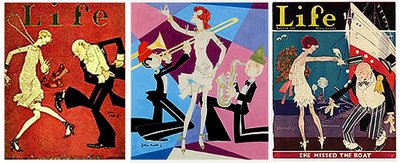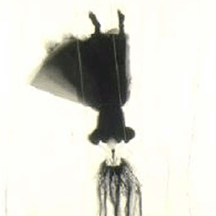
art | design | fashion
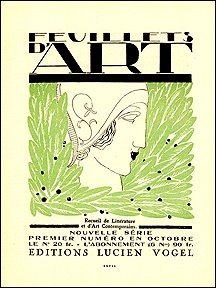
Saturday, December 23, 2006
Thursday, December 07, 2006
the arts and crafts movement
" The Arts & Crafts Movement was a rebellion of substance as well as style. Its power came from the conviction that art and craft could change people's lives. Its strong social and moral purpose has ensured its continuing relevance. Many guilds and workshops were set up which had a long lasting impact on communities. The work could be highly decorated but was often extremely plain. The roughness and simplicity of some work was shocking, one reviewer in 1899 referred to an Arts & Crafts piece as looking 'like the work of a savage'. However most pieces show a concern for and understanding of craftsmanship. The bright colours, rich patterns and textures of many pieces are visually stunning. " place holder -- more to come
arts and crafts style items
More shameless commerce from the kora in hell shop:
The items below are part of a series for the year illustrating four fruits of the seasons that will change quarterly over the year. The four different designs are shown in the calendar.





Labels:
arts and crafts,
pomegranates,
shameless commerce
Tuesday, September 26, 2006
modernist fashion history
- orientalism in brief
- paul poiret
- the ballet russe
- josephine baker and modern dance history
- the new woman
- the new shape
- folies and follies
- josephine baker (biography)
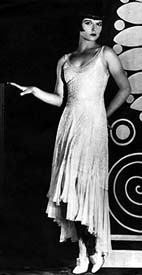

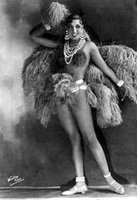
(Pictured: Louise Brooks, Florence Mills, Josephine Baker)
These new posts are all up but there are still some problems with links. I'm working on them now.
Saturday, September 23, 2006
orientalism in brief
Orientalism
Orientalism specifically describe a fashion trend in the first decades of the twentieth century but the word generally refers to all different kinds of phenomenon that involve Western (American and European, especially) interpretations of Eastern cultures that are often very imaginary, stereotypical, and based on ideas of western superiority.
Orientalism, as a concept of "what is the East" is as old as "what is the West." To put another way, the barbarian is invented by the civilized as a way of distinguishing themselves.
At any rate, the import of textiles and other commodities from the East dates back to the silk road and the very formation of Europe itself. Over the centuries its vogue had surged and ebbed with the fashions of the times and the exploits of explorers and empire builders.
The West's conceptions of “the orient” are not exclusive limited to Asia but extend to many other areas of the globe including the middle east, the south Pacific, parts of Africa, classical Greece and ancient Egypt, and even parts of Eastern Europe. The larger fascination with “ethnic” styles included orientalist styles, all “folk” cultures, and what was considered “primitive”cultures (i.e., anything not European).
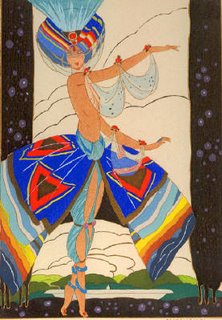 Resources
ResourcesOrientalism is not something that only happened in the past. It is as alive and well today as it ever was. For more information, especially as it relates to the important book by Edward Said (Orientalism, New York: Vintage, 1979) you can start with these resources:
1. start here for a general overview
2. then go here for a discussion of the term as used in Said’s book
paul poiret
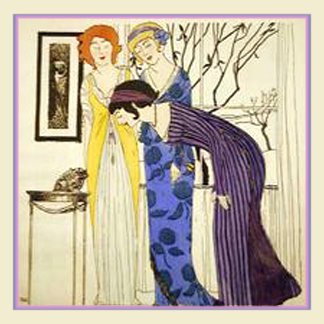
Paul Poiret is one of the earliest designers of the dress style for the modern "new woman": a slender style that loosely fit the body (the "Nouvelle Vague") which liberated women from the corset and allowed for greater freedom of movement. He was inspried by the stylings of ancient Greece as well as the Empire gown which elongated the torso and he was particularly fond of headscarves and turbans.
Poiret is also noted for a number of style innovations. His orientalist fashions can be seen in the kimono gowns (see above, the blue gown in the middle) and turkish robes and other styles that wrapped the body and hung losely in soft folds. He introduced harem pants which became all the rage when the Ballet Russe came to Paris.
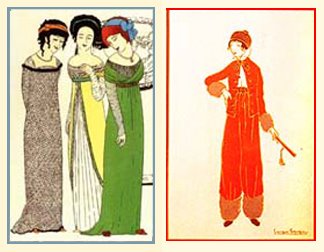
His least appealing design is the hobble skirt, which was tight around the ankles. Why someone who promoted the idea of creating fashion that gave women more freedom created something as silly as the hobble skirt is something of a mystery.
However, he later modified the design so that the skirt was split in the middle, with a gathered folds cascading down the middle.
His lampshade dress was another radical transformation in the architecture of women's fashion. It was also an item that worked well with his harem pants and modified (i.e. no longer hobbling) hobble skirt.
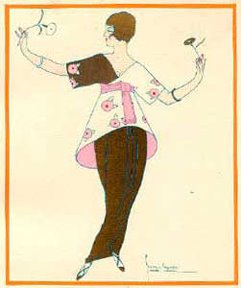 During this period fashion illustration became an art form in its own right and Poiret's work was enhanced by the work of Paul Iribe and Georges Lepape and others who produced beautiful images that captured not just the clothing but a particular way of life -- full of romance, leisure, langor, and style.
During this period fashion illustration became an art form in its own right and Poiret's work was enhanced by the work of Paul Iribe and Georges Lepape and others who produced beautiful images that captured not just the clothing but a particular way of life -- full of romance, leisure, langor, and style.
Resources
Orientalism and Fashion
Art Deco fashion illustration
Fox Rare Books : fashion illustration
Gazette du Bon Ton fashions at victoriana.com
the ballet russe
The Ballet Russe's arrival in France profoundly influenced all art forms but it had an especially dramatic and visible impact on fashion. Serge Diaghilev (1872-1929) formed the Ballet Russe in 1909, and they performed in Paris nearly every year until 1929 when the company was disbanded. Parisians were enthralled by performances by dancers such as Anna Pavlova and Vladimir Nijinsky in compositions by composers such as Nicolas Rimsky-Korsakov, Igor Stravinsky and Claude Debussy.
The company's first choreographer, Michel Fokine, brought an expressive and more natural style to the staid technique-obsessed world of ballet, which was loosing audiences who were more excited by the "free dance" movement that broke free of the rigid formalism of ballet.
Click here for a brief explanation of "free dance," "modern dance" and its connection to dancers at the Folies Bergere.
In its first season it performed Cleopatra -- one of the "oriental operas" but it was its second season’s performance of Scherzerezhade that particularly captured the imagination of the public. As important as the dance and music was the impact of the set and costume designs done by the Russian Artist Leon Bakst.
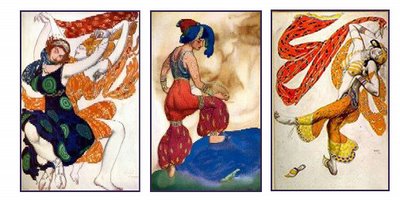 The exotic themed ballets of the Ballet Russe and Leon Bakst's vivid and innovative costumes sparked a fascination with fashion inspired by the Middle East--or, their fantasies of the East.
The exotic themed ballets of the Ballet Russe and Leon Bakst's vivid and innovative costumes sparked a fascination with fashion inspired by the Middle East--or, their fantasies of the East.
Click here for a brief introduction to the concept of "orientalism."
It is significant that this fashion inspiration came from the ballet because, as I discussed earlier, the designers were creating clothing for a "new woman" who was energetic, active and--often dancing herself. These costumes were designed to allow the body to move and to emphasize its movements.
Europeans were captivated by art and design that evoked notions of the "folk" or "primitive" or "exotic." During the 1880s and 1890s with the Art Nouveau style explored these themes and continued into the 1920s with Art Deco, which incorporated ideas from the early avant-garde movements such as Cubism. The Ballet Russe was an essential part of this phenomenon and was a significant link between these two aesthetics movements, which can all be seen as facets of La Belle Époque!
Perhaps nowhere were these connections more evident than in the world of fashion and, especially in the designs by Paul Poiret. Poiret opened his salon in 1903 and was experimenting with Eastern-influences fabrics and styles before the arrival of the Ballet Russe in 1909. Yet the combination of the two produced a fashion phenomenon.
Click here for a brief introduction to some of the fashion designs of Paul Poiret.
Resources
Diaghilev's Ballets Russes -- biographies, ballet descriptions and a chronology of all of their performances in Paris
Ballet Russe and the Dance Revolution
An online exhibit on Ballet Russe costumes
More Leon Bakst costume designs
Russian Orientalism and the Ballet Russe by Laurel Victoria Gray (article)
The company's first choreographer, Michel Fokine, brought an expressive and more natural style to the staid technique-obsessed world of ballet, which was loosing audiences who were more excited by the "free dance" movement that broke free of the rigid formalism of ballet.
Click here for a brief explanation of "free dance," "modern dance" and its connection to dancers at the Folies Bergere.
In its first season it performed Cleopatra -- one of the "oriental operas" but it was its second season’s performance of Scherzerezhade that particularly captured the imagination of the public. As important as the dance and music was the impact of the set and costume designs done by the Russian Artist Leon Bakst.
 The exotic themed ballets of the Ballet Russe and Leon Bakst's vivid and innovative costumes sparked a fascination with fashion inspired by the Middle East--or, their fantasies of the East.
The exotic themed ballets of the Ballet Russe and Leon Bakst's vivid and innovative costumes sparked a fascination with fashion inspired by the Middle East--or, their fantasies of the East.Click here for a brief introduction to the concept of "orientalism."
It is significant that this fashion inspiration came from the ballet because, as I discussed earlier, the designers were creating clothing for a "new woman" who was energetic, active and--often dancing herself. These costumes were designed to allow the body to move and to emphasize its movements.
Europeans were captivated by art and design that evoked notions of the "folk" or "primitive" or "exotic." During the 1880s and 1890s with the Art Nouveau style explored these themes and continued into the 1920s with Art Deco, which incorporated ideas from the early avant-garde movements such as Cubism. The Ballet Russe was an essential part of this phenomenon and was a significant link between these two aesthetics movements, which can all be seen as facets of La Belle Époque!
Perhaps nowhere were these connections more evident than in the world of fashion and, especially in the designs by Paul Poiret. Poiret opened his salon in 1903 and was experimenting with Eastern-influences fabrics and styles before the arrival of the Ballet Russe in 1909. Yet the combination of the two produced a fashion phenomenon.
Click here for a brief introduction to some of the fashion designs of Paul Poiret.
Resources
Diaghilev's Ballets Russes -- biographies, ballet descriptions and a chronology of all of their performances in Paris
Ballet Russe and the Dance Revolution
An online exhibit on Ballet Russe costumes
More Leon Bakst costume designs
Russian Orientalism and the Ballet Russe by Laurel Victoria Gray (article)
josephine baker and modern dance history
A brief foray into dance history order to point out why the popular version of the history of modern dance is wrong because it leaves josephine baker out of the story . . .
Three American women dancers--Loie Fuller, Isadora Duncan, and Ruth St. Denis--radically transformed dance as a creative form, breaking the ground that led to the development of American modern dance.

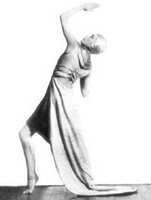

(Above: Loie Fuller, Ruth St. Denis, Isadora Duncan)
Loie Fuller and Ruth St. Denis emerged from vaudeville traditions, and Fuller, like Josephine Baker later, starred in the Folies Bergere where she was famous for her "serpentine dance" and "fire dance".
In the conventional story of the development of modern dance Baker is often not mention in the conventional story about the development of modern dance.
One reason for this is that dance history is often overly categorized and thus different strands that are important to each other are separated from each other: classical, concert, popular, ballroom, swing, jazz, folk, burlesque. Modern dance, like the other arts in the early twentieth century, drew from all of these sources and more, such as attempts to reimagine the dances of ancient Greece, folk dances of Eastern Europe, and dance from cultures around the world including Persia, Egypt, not to mention African and the Caribbean dances which were already at the core of popular American dance.
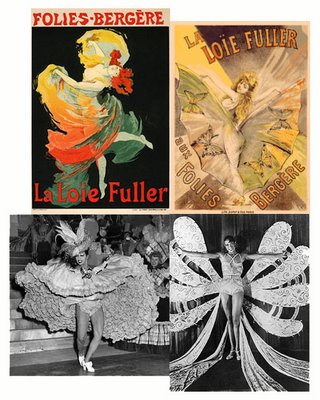 Baker -- like Fuller -- was most famous for her roles in burlesque forms of dancing. Baker was particularly constrained by the roles and even choreography that was created for her. She routinely "forgot" the steps and substituted her own choreography--which was a more accurate representation of African American dance styles as opposed to the French fantasies developed for audiences possessed by fantasy stereotypes of the erotic African woman: the primitive. She may not have been able to escape the stereotypes she was required to perform, but within those constraints she is considered an artist who was extraordinarily innovative -- and unquestionably skilled.
Baker -- like Fuller -- was most famous for her roles in burlesque forms of dancing. Baker was particularly constrained by the roles and even choreography that was created for her. She routinely "forgot" the steps and substituted her own choreography--which was a more accurate representation of African American dance styles as opposed to the French fantasies developed for audiences possessed by fantasy stereotypes of the erotic African woman: the primitive. She may not have been able to escape the stereotypes she was required to perform, but within those constraints she is considered an artist who was extraordinarily innovative -- and unquestionably skilled.
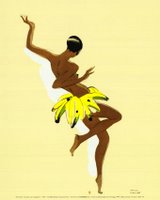
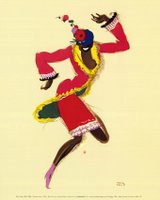
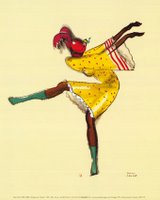
(artwork by paul collins)
Twentieth century concert dance is concerned with reworking of dance traditions and Baker was a key figure in the process that led to the understanding of African diaspora dance as an art form to be taken as seriously as ballet. Josephine Baker is important to the development modern concert dance not in spite of her being a popular entertainer but because of her extraordinary innovations as a popular dancer.
Note: I know that Baker is not the first, the last, or the only person who has been left out of the mainstream story of dance. Dance emerges from so many different places and, along with music, it spreads so quickly through the wider culture. I encourage you to suggest more.
Three American women dancers--Loie Fuller, Isadora Duncan, and Ruth St. Denis--radically transformed dance as a creative form, breaking the ground that led to the development of American modern dance.



(Above: Loie Fuller, Ruth St. Denis, Isadora Duncan)
Loie Fuller and Ruth St. Denis emerged from vaudeville traditions, and Fuller, like Josephine Baker later, starred in the Folies Bergere where she was famous for her "serpentine dance" and "fire dance".
In the conventional story of the development of modern dance Baker is often not mention in the conventional story about the development of modern dance.
One reason for this is that dance history is often overly categorized and thus different strands that are important to each other are separated from each other: classical, concert, popular, ballroom, swing, jazz, folk, burlesque. Modern dance, like the other arts in the early twentieth century, drew from all of these sources and more, such as attempts to reimagine the dances of ancient Greece, folk dances of Eastern Europe, and dance from cultures around the world including Persia, Egypt, not to mention African and the Caribbean dances which were already at the core of popular American dance.
 Baker -- like Fuller -- was most famous for her roles in burlesque forms of dancing. Baker was particularly constrained by the roles and even choreography that was created for her. She routinely "forgot" the steps and substituted her own choreography--which was a more accurate representation of African American dance styles as opposed to the French fantasies developed for audiences possessed by fantasy stereotypes of the erotic African woman: the primitive. She may not have been able to escape the stereotypes she was required to perform, but within those constraints she is considered an artist who was extraordinarily innovative -- and unquestionably skilled.
Baker -- like Fuller -- was most famous for her roles in burlesque forms of dancing. Baker was particularly constrained by the roles and even choreography that was created for her. She routinely "forgot" the steps and substituted her own choreography--which was a more accurate representation of African American dance styles as opposed to the French fantasies developed for audiences possessed by fantasy stereotypes of the erotic African woman: the primitive. She may not have been able to escape the stereotypes she was required to perform, but within those constraints she is considered an artist who was extraordinarily innovative -- and unquestionably skilled.


(artwork by paul collins)
Twentieth century concert dance is concerned with reworking of dance traditions and Baker was a key figure in the process that led to the understanding of African diaspora dance as an art form to be taken as seriously as ballet. Josephine Baker is important to the development modern concert dance not in spite of her being a popular entertainer but because of her extraordinary innovations as a popular dancer.
Note: I know that Baker is not the first, the last, or the only person who has been left out of the mainstream story of dance. Dance emerges from so many different places and, along with music, it spreads so quickly through the wider culture. I encourage you to suggest more.
Friday, September 22, 2006
disclaimers
1. I apologize for the number of errors. My excuse for posting something so rough is that I wanted to get the basic information up before the new PR episode and before Fashion Week is too long gone. I'll be polishing it over the next few days. 2. This material is not a general work of fashion history and it is not intended to be a reference for scholars. I recommend looking at fashion-era.com as an online resource for finding materials on fashion history. If you are doing work for a school project you should also go to the library to do proper research on your subject. 3. That said, you are welcome to quote any of this text provided you use a citation. As a courtesy it would be nice to email me first. 4. I appreciate your comments and corrections. thanks. trixie / kora in hell
the new woman
Along with the skyscraper and jazz, the New Woman, especially the flapper, was the emblem of modernism.
The flapper was the peak of the various images of the "new woman" that emerged in the late nineteenth and early twentieth centuries : she was youthful, single, and in constant movement. She danced to the sounds of the new jazz, she wore short dresses and high heels and rolled stockings, she smoked cigarettes, she put on makeup, bobbed her hair, and she stayed out late without a chaperone.

She also travelled--and even if she didn't travel she had a much wider view of the world and a far greater interest in exotic cultures than the women of previous generations. And the New Woman shopped. Department stores had emerged in the late decades of the 19th century but by the 1920s consumer culture was in full swing, so to speak.
social context
There was a loosening of attitudes and mores following the war. It was also a time of major transformations in science and technology that was rapidly changing the way that people lived and their awareness and understanding of the larger world. These innovations even altered the way that people perceived reality. Young men and women looking for excitement flooded into the cities. Artistic circles emerged in the cities of the US and Europe and the artists circulated between the cities. The artistic avant-garde advocated throwing away the traditions of the past and embracing everything that was new.
This was also the time when women advocated for the right to vote, the right to birth control, for entry into exclusively male bastions of education, for their rights in marriage and divorce, and for financial rights, such as inheritance laws.
The suffragette represented the political changes for women. The flapper was the image of the social changes. Both images scared the lights out of traditionalists who saw in them everything that was wrong with the modern era.

harlem
A key aspect of this cultural transformation was its roots in African American culture. The increasing size of the urban African American population had created large communities that were far from utopian. Indeed they were a segregated, impoverished and exploited group. Yet the community also fostered new developments in African American art and culture that quickly spread into the culture at large.
The most significant of these is the Harlem Renaissance: a place and time that fostered all types of art including music, dance, literature, painting, sculpture, photography and theater. The early blues singers who performed in the clubs in Harlem were flappers (below: Florence Mills, Ethel Waters, Bessie Smith):
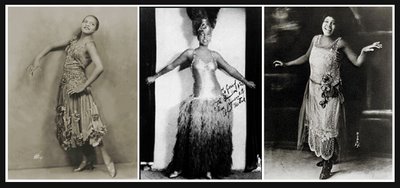 Mainstream America became increasing interested in and influenced by African American music and dance. Indeed, the "Charleston" -- the dance that flappers were most associated with -- is thought to have originated in New Orleans and came to Harlem along with the blues and swing music.
Mainstream America became increasing interested in and influenced by African American music and dance. Indeed, the "Charleston" -- the dance that flappers were most associated with -- is thought to have originated in New Orleans and came to Harlem along with the blues and swing music.
hollywood
From there it travelled across the continent to Los Angeles where the film industry's of was moving from silent to talking films and where flappers were the queens of the silent film were (below, from left to right: Colleen Moore, Clara Bow and Louise Brooks).

paris
This phenomenon was not limited to the United States. Indeed it reached around the globe and it drew its influences from around the globe -- especially from Africa where western imperial expansion had made Europeans and Americans more familiar with its different artistic traditions.
One of the most important figures in the European (and especially French) enthrallment with African and African American culture was Josephine Baker. (Click here for more information on Josephine Baker.)
josephine baker
Baker is, among many other things, one of the great fashion icons of the early twentieth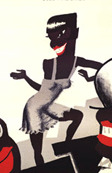 century.
century.
This image (at right) shows Baker in a flapper dress (from a poster for the Revue Negre, a racist depiction that was part of the graphic style of the time).
Her style shifted between the racy Folies Bergere costumes or couture gowns of structured taffeta couture creations of structured taffita or languid beaded silk.
 Her image encompassed more than the flapper and the new woman. Josephine Baker brought together the elaborate stage show of revues, the African American dance club, and the European fantasy of the "sauvage".
Her image encompassed more than the flapper and the new woman. Josephine Baker brought together the elaborate stage show of revues, the African American dance club, and the European fantasy of the "sauvage".
links:
Baker fashion designs
Photo Gallery
National Portrait Gallery Le Tumult Noir: Paul Colin's Jazz Age Portfolio
The flapper was the peak of the various images of the "new woman" that emerged in the late nineteenth and early twentieth centuries : she was youthful, single, and in constant movement. She danced to the sounds of the new jazz, she wore short dresses and high heels and rolled stockings, she smoked cigarettes, she put on makeup, bobbed her hair, and she stayed out late without a chaperone.

She also travelled--and even if she didn't travel she had a much wider view of the world and a far greater interest in exotic cultures than the women of previous generations. And the New Woman shopped. Department stores had emerged in the late decades of the 19th century but by the 1920s consumer culture was in full swing, so to speak.
social context
There was a loosening of attitudes and mores following the war. It was also a time of major transformations in science and technology that was rapidly changing the way that people lived and their awareness and understanding of the larger world. These innovations even altered the way that people perceived reality. Young men and women looking for excitement flooded into the cities. Artistic circles emerged in the cities of the US and Europe and the artists circulated between the cities. The artistic avant-garde advocated throwing away the traditions of the past and embracing everything that was new.
This was also the time when women advocated for the right to vote, the right to birth control, for entry into exclusively male bastions of education, for their rights in marriage and divorce, and for financial rights, such as inheritance laws.
The suffragette represented the political changes for women. The flapper was the image of the social changes. Both images scared the lights out of traditionalists who saw in them everything that was wrong with the modern era.

harlem
A key aspect of this cultural transformation was its roots in African American culture. The increasing size of the urban African American population had created large communities that were far from utopian. Indeed they were a segregated, impoverished and exploited group. Yet the community also fostered new developments in African American art and culture that quickly spread into the culture at large.
The most significant of these is the Harlem Renaissance: a place and time that fostered all types of art including music, dance, literature, painting, sculpture, photography and theater. The early blues singers who performed in the clubs in Harlem were flappers (below: Florence Mills, Ethel Waters, Bessie Smith):
 Mainstream America became increasing interested in and influenced by African American music and dance. Indeed, the "Charleston" -- the dance that flappers were most associated with -- is thought to have originated in New Orleans and came to Harlem along with the blues and swing music.
Mainstream America became increasing interested in and influenced by African American music and dance. Indeed, the "Charleston" -- the dance that flappers were most associated with -- is thought to have originated in New Orleans and came to Harlem along with the blues and swing music.hollywood
From there it travelled across the continent to Los Angeles where the film industry's of was moving from silent to talking films and where flappers were the queens of the silent film were (below, from left to right: Colleen Moore, Clara Bow and Louise Brooks).

paris
This phenomenon was not limited to the United States. Indeed it reached around the globe and it drew its influences from around the globe -- especially from Africa where western imperial expansion had made Europeans and Americans more familiar with its different artistic traditions.
One of the most important figures in the European (and especially French) enthrallment with African and African American culture was Josephine Baker. (Click here for more information on Josephine Baker.)
josephine baker
Baker is, among many other things, one of the great fashion icons of the early twentieth
 century.
century.This image (at right) shows Baker in a flapper dress (from a poster for the Revue Negre, a racist depiction that was part of the graphic style of the time).
Her style shifted between the racy Folies Bergere costumes or couture gowns of structured taffeta couture creations of structured taffita or languid beaded silk.
 Her image encompassed more than the flapper and the new woman. Josephine Baker brought together the elaborate stage show of revues, the African American dance club, and the European fantasy of the "sauvage".
Her image encompassed more than the flapper and the new woman. Josephine Baker brought together the elaborate stage show of revues, the African American dance club, and the European fantasy of the "sauvage".links:
Baker fashion designs
Photo Gallery
National Portrait Gallery Le Tumult Noir: Paul Colin's Jazz Age Portfolio
the new shape
Note: I've not finished creating the reference and image links. sorry for the delay.
The early twentieth century was an astounding period of change in fashion. The most dramatic change was the revisioning of the shape of a woman's body: from an extreme S-curve hightened by bustles and corsets to the languid cursive "I" that draped loosely but close to the body.
 Portrait of Mrs. George Gribble [Norah], 1888, painting by John Singer Sargent
Portrait of Mrs. George Gribble [Norah], 1888, painting by John Singer Sargent
Peggy Guggenheim [in a gown by Paul Poiret] 1924 photograph by Man Ray
Within just a few years the body lengthened, the curves were softened, if not completely flattened, the draping loosened, the heaviness of the fabric lightened and layers of fabric were reduced to a minumum.
two paintings
Changes in fashion accompanied changes in the aesthetics of fine artists such as painters. The two portraits below are of very similiar subject matter: the meditative girl or young woman just on the brink of adulthood, are dressed in simple white dresses, representing their innocence and virginity.
While none of these images (above) are exclusively trying to depict an accurate physical recreation of a women's body (which is neither the extreme curves of the S or the straight line of the I). Art works convey more than factual information: their complexity of meanings can also put the fashions into wider social and aesthetic contexts.
Fashion is, after all, about the adornment of the body not its stripping. Nonetheless, it is fair to say that there was a significant change in the style of dress for women during the early decades of the twentieth century and the new styles generally made the body more visible and less constrained. The reasons for this change were varied -- all fashion changes have a certain element of whimsy -- but the radical alteration in line and architecture signals that designers were making clothes for a very different type of woman.
The early twentieth century was an astounding period of change in fashion. The most dramatic change was the revisioning of the shape of a woman's body: from an extreme S-curve hightened by bustles and corsets to the languid cursive "I" that draped loosely but close to the body.
 Portrait of Mrs. George Gribble [Norah], 1888, painting by John Singer Sargent
Portrait of Mrs. George Gribble [Norah], 1888, painting by John Singer SargentPeggy Guggenheim [in a gown by Paul Poiret] 1924 photograph by Man Ray
Within just a few years the body lengthened, the curves were softened, if not completely flattened, the draping loosened, the heaviness of the fabric lightened and layers of fabric were reduced to a minumum.
Paul Iribe Les Robes de Paul Poiret (1909)
two paintings
Changes in fashion accompanied changes in the aesthetics of fine artists such as painters. The two portraits below are of very similiar subject matter: the meditative girl or young woman just on the brink of adulthood, are dressed in simple white dresses, representing their innocence and virginity.
Jeanne Hbuterne, Left Arm Behind her Head , 1919 , A. Modigliani, Barnes Foundation,
However the dress on the left clearly has many layers of ruffles and petticoats and is designed to emphasize the fullness of the body and to call attention to the bust and waist. The dress on the right also has a waist but it is barely noticeable. The dress falls straight in order to call attention to the length of the line. The rich luminous color of the Henri painting also contrasts with Modigliani's spare, stark coloring. The softness in color accentuates the softness of the figure and her relaxed body with only the hint of movement in her hands. Modigliani mannerist figure is in the midst of an active movement, stretching and twisting her body in a way that is sharp and awkward.
ancient greece
First time (in the western world) since ancient Greece fabric was draped on a woman's body in a way that did not hide or alter her shape. It is not surprising therefore that many of the designers were inspired by the styles in ancient Greek art.
ancient greece
First time (in the western world) since ancient Greece fabric was draped on a woman's body in a way that did not hide or alter her shape. It is not surprising therefore that many of the designers were inspired by the styles in ancient Greek art.
Left: Running Girl, Peloponnesian. British Museum.
Right: 1921 cover of Vanity Fair.
Right: 1921 cover of Vanity Fair.
While none of these images (above) are exclusively trying to depict an accurate physical recreation of a women's body (which is neither the extreme curves of the S or the straight line of the I). Art works convey more than factual information: their complexity of meanings can also put the fashions into wider social and aesthetic contexts.
Fashion is, after all, about the adornment of the body not its stripping. Nonetheless, it is fair to say that there was a significant change in the style of dress for women during the early decades of the twentieth century and the new styles generally made the body more visible and less constrained. The reasons for this change were varied -- all fashion changes have a certain element of whimsy -- but the radical alteration in line and architecture signals that designers were making clothes for a very different type of woman.
folie folly fo fana . . .
Note: reference links for text and images will be up as soon as possible. Sorry for the delay.
I'll start with a stab at a definition
folie, folly : the primary meaning comes from the French and is the word for madness
derangement, mania,
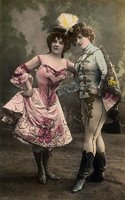 theatrical follies
theatrical follies
Folies and follys are also a theatrical genre, also called revues: they were elaborate variety shows consisting of numerous scenes, comic, musical, dance and skits, and usually some – if not all -- was burlesque in nature; the dancers performed solo (often erotic dances that were primarily nude) as well as in chorus lines with dances such as the "Can-Can".
The famous revues such as the Folies Berge[`]re and Ziegfield Follies were notable for the glamour of its female performers and the outlandishness of their costumes.
These shows were at their heyday in the late 19th and early 20th centuries.

Commedia dell'Arte
The French folies combined modern elements such as flapper dancers with older elements from the Italian Commedia dell'Arte:

and its later French theatrical versions known as pantomimes.
Harlequinade
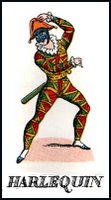

Harlequin : from Arlecchino in the Italian renaissance theater of the Commedia dell'Arte. The harlequin is a trickster character who wears a parti-colored costume and carries a magic wand.
The harlequin derives from medieval Italian legends of the devil or a group of devils horsemen that ride in the night.
Harlequinade : a pantomime in which the harlequin and clown play the principal parts. For more information on this and the costume of the harlequin click here.

During the first decades of the 20th century artists, writers, choreographers and composers all took up the theme of the harlequinade. They were questioning the hierarchies and divisions in art (and the broader social world) and for their inspiration they drew upon art that was created for popular entertainment such as the Commedia dell'Arte and the Circus. There are too many examples and the topic is too rich to investigate in this context but one well-known example of this was Picasso. He considered the harlequin his alter ego and he collaborated with Stravinsky on the designs for his ballet Pulcinella.


Pierrot :
The French theater’s development of the Italian Commedia dell'Arte character Pedrolino.
He wears a loose white costume with a neck ruff, and a high hat with a wide floppy brim.
The most famous image of Perriot is the 1718 painting, Pierrot also known as Gilles, by Jean-Antoine Watteau 1684-1721:
fashion terminology :
harlequin : an adjective to describe any sort of particoloured item:

pierrot collar : layers of large folded ruffles at the neck.
Note: Chanel's collar is smaller and not as loose as the one on the left but it has the construction of a pierrot as opposed to the folded Elizabethen ruff:
 finally
finally

Las Vegas show girls and the Rockettes are the vestiges of the chorus line; sitcoms and stand-up comedy have replaced vaudeville; in some respects fashion shows are a type of modern-day follies. These spectacles offer us a parade of women (and men but to a much lesser extent). The fashion shows cut to the chase of the follies: the various entertainments are jettisoned in order to focus on the main attraction: beautiful women in elaborate costumes.
Like the famous "Ziegfeld Girls" it consists of only a very particular type of ideal woman. Furthermore, unlike the performers in theatrical chorus lines, top models become idolized around the country, and around the globe -- and therefore have the level of wide appeal that is similar to the follies in their day.

I'll start with a stab at a definition
folie, folly : the primary meaning comes from the French and is the word for madness
derangement, mania,
folie à deux : communicated insanityWhile the French word folie has a number of different uses, it is, unsurprisingly, more narrowly defined than the English word folly. The English "folly" is not used to describe the mental state of madness or mania but it is used to describe something that is, among other things:
la folie des grandeurs : megalomania
foolish, buffoonish; whimsical, fantastical, absurd, discordant, wicked, evil, tawdry, wanton, lewd, burlesque; a sexual affair, a lark, a misadventure, and a massive undertaking ending in failure . . .
 theatrical follies
theatrical folliesFolies and follys are also a theatrical genre, also called revues: they were elaborate variety shows consisting of numerous scenes, comic, musical, dance and skits, and usually some – if not all -- was burlesque in nature; the dancers performed solo (often erotic dances that were primarily nude) as well as in chorus lines with dances such as the "Can-Can".
The famous revues such as the Folies Berge[`]re and Ziegfield Follies were notable for the glamour of its female performers and the outlandishness of their costumes.
These shows were at their heyday in the late 19th and early 20th centuries.
“In novelty of ideas, variety, talent of performers and general smartness of production, [the Ziegfeld] ‘Follies of 1908’ is fully up to the standard of the best this enterprising young manager [Ziegfeld] has yet attempted.” (1908 Theatre Mag. (U.S.) Aug. 201/1 ) From the Oxford English Dictionary.American follies had stronger ties to minstrel shows and vaudeville. Both American and French genres had roots in the circus and traditions of traveling acting troupes.

Commedia dell'Arte
The French folies combined modern elements such as flapper dancers with older elements from the Italian Commedia dell'Arte:

and its later French theatrical versions known as pantomimes.
Harlequinade


Harlequin : from Arlecchino in the Italian renaissance theater of the Commedia dell'Arte. The harlequin is a trickster character who wears a parti-colored costume and carries a magic wand.
The harlequin derives from medieval Italian legends of the devil or a group of devils horsemen that ride in the night.
Harlequinade : a pantomime in which the harlequin and clown play the principal parts. For more information on this and the costume of the harlequin click here.

During the first decades of the 20th century artists, writers, choreographers and composers all took up the theme of the harlequinade. They were questioning the hierarchies and divisions in art (and the broader social world) and for their inspiration they drew upon art that was created for popular entertainment such as the Commedia dell'Arte and the Circus. There are too many examples and the topic is too rich to investigate in this context but one well-known example of this was Picasso. He considered the harlequin his alter ego and he collaborated with Stravinsky on the designs for his ballet Pulcinella.


Pierrot :
The French theater’s development of the Italian Commedia dell'Arte character Pedrolino.
He wears a loose white costume with a neck ruff, and a high hat with a wide floppy brim.
The most famous image of Perriot is the 1718 painting, Pierrot also known as Gilles, by Jean-Antoine Watteau 1684-1721:
fashion terminology :
harlequin : an adjective to describe any sort of particoloured item:

(Above: from Jay McCarroll's Spring 2007 collection.)
pierrot collar : layers of large folded ruffles at the neck.
Note: Chanel's collar is smaller and not as loose as the one on the left but it has the construction of a pierrot as opposed to the folded Elizabethen ruff:
 finally
finally
Las Vegas show girls and the Rockettes are the vestiges of the chorus line; sitcoms and stand-up comedy have replaced vaudeville; in some respects fashion shows are a type of modern-day follies. These spectacles offer us a parade of women (and men but to a much lesser extent). The fashion shows cut to the chase of the follies: the various entertainments are jettisoned in order to focus on the main attraction: beautiful women in elaborate costumes.
Like the famous "Ziegfeld Girls" it consists of only a very particular type of ideal woman. Furthermore, unlike the performers in theatrical chorus lines, top models become idolized around the country, and around the globe -- and therefore have the level of wide appeal that is similar to the follies in their day.

Subscribe to:
Posts (Atom)

